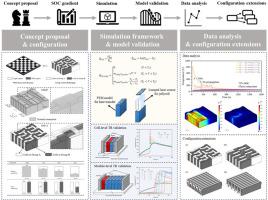SOC gradient-based passive safety design: a chessboard-inspired structural configuration for mitigating thermal runaway propagation in lithium-ion battery packs
IF 17
1区 工程技术
Q1 ENERGY & FUELS
引用次数: 0
Abstract
In conventional lithium-ion battery packs, adjacent cells are interconnected through series-parallel arrangements, where thermal runaway in a single cell can trigger cascading thermal propagation, leading to catastrophic thermal events. To address this issue, we propose a novel chessboard-inspired battery pack featuring two interdigitated cell groups with alternating state-of-charge (SOC) distribution. During operation, the sequential discharge of these groups creates spatial SOC differentiation. Each high-SOC cell is strategically surrounded by lower-SOC neighbors that serve as inherent thermal buffers. A comparative safety analysis was conducted between conventional and chessboard-inspired pack configurations using a validated thermal runaway propagation model. Simulation results reveal that only the chessboard architecture successfully inhibits the thermal runaway propagation in the 75 %-SOC battery pack. The 50 %-SOC cells surrounding thermal failed cell unit increase the thermal propagation threshold by 22 °C compared to conventional packs with 75 %-SOC cells. In addition, energy flow analysis indicates that the specialized tab design redirects approximately 10 % of the energy released during thermal runaway to non-adjacent cells. This redistribution further increases the required energy release from the initial thermal runaway cell to trigger propagation. Through the integration of geometric layout and operational strategies, the chessboard-inspired configuration demonstrates strong potential for practical applications in electric vehicles and energy storage systems, offering a promising pathway for advancing passive safety technologies in battery system design.

基于SOC梯度的被动安全设计:棋盘式结构配置,可缓解锂离子电池组的热失控传播
在传统的锂离子电池组中,相邻的电池通过串并联的方式相互连接,单个电池的热失控会引发级联热传播,导致灾难性的热事件。为了解决这个问题,我们提出了一种新颖的棋盘式电池组,具有两个交错的电池组,具有交替充电状态(SOC)分布。在运行过程中,这些群体的连续放电产生了空间SOC分化。每个高soc电池都被低soc邻居策略性地包围,作为固有的热缓冲。采用经过验证的热失控传播模型,对传统和棋盘式包结构进行了安全性对比分析。仿真结果表明,在75% -SOC电池组中,只有棋盘结构才能成功抑制热失控传播。与采用75% -SOC电池的传统电池组相比,热失效电池单元周围的50% -SOC电池可将热传播阈值提高22°C。此外,能量流分析表明,特殊的标签设计将热失控过程中释放的大约10%的能量重定向到非相邻的电池。这种再分配进一步增加了从初始热失控细胞释放的触发传播所需的能量。通过几何布局和操作策略的整合,棋盘启发的配置显示出在电动汽车和储能系统中实际应用的强大潜力,为推进电池系统设计中的被动安全技术提供了一条有希望的途径。
本文章由计算机程序翻译,如有差异,请以英文原文为准。
求助全文
约1分钟内获得全文
求助全文
来源期刊

Etransportation
Engineering-Automotive Engineering
CiteScore
19.80
自引率
12.60%
发文量
57
审稿时长
39 days
期刊介绍:
eTransportation is a scholarly journal that aims to advance knowledge in the field of electric transportation. It focuses on all modes of transportation that utilize electricity as their primary source of energy, including electric vehicles, trains, ships, and aircraft. The journal covers all stages of research, development, and testing of new technologies, systems, and devices related to electrical transportation.
The journal welcomes the use of simulation and analysis tools at the system, transport, or device level. Its primary emphasis is on the study of the electrical and electronic aspects of transportation systems. However, it also considers research on mechanical parts or subsystems of vehicles if there is a clear interaction with electrical or electronic equipment.
Please note that this journal excludes other aspects such as sociological, political, regulatory, or environmental factors from its scope.
 求助内容:
求助内容: 应助结果提醒方式:
应助结果提醒方式:


